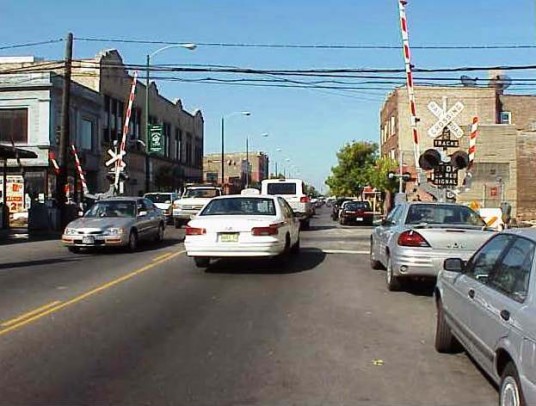Report examines behaviors at rail grade crossings
 A new UIC Urban Transportation Center report details some of the attitudes and behaviors of pedestrians and bicyclists at Chicago Transit Authority rail grade crossings.
A new UIC Urban Transportation Center report details some of the attitudes and behaviors of pedestrians and bicyclists at Chicago Transit Authority rail grade crossings.
“In the last 10 years, contrary to a decrease in the number of train-vehicle collisions at highway-rail grade crossings, the number of pedestrian and bicycle fatalities at highway-rail grade crossings has increased,” said Paul Metaxatos, UTC associate director for research programs and research associate professor, who prepared the report with P.S. Sriraj, UTC interim executive director and research associate professor.
Metaxatos and Sriraj conducted surveys and studied pedestrian and cyclist activity at grade-level crossings located at seven CTA rapid transit stations on the Yellow Line in Skokie, the Pink Line in Cicero and Chicago and the Brown Line in Chicago.
Using pen and paper surveys, the researchers collected feedback from more than 200 people ranging in age from 18 to 70. The majority of those respondents surveyed – 98 percent – were walking, with the remainder riding a bicycle. Surveys were conducted between 6 a.m. and 1 p.m.
The report, “Pedestrian/Bicyclist Warning Devices and Signs at CTA Rail-Highway Grade Crossings,” does not address whether the CTA is compliant or non-compliant with warning and signal devices at the seven stations covered.
The survey revealed that up to 25 percent of the respondents, on occasion, would still cross the tracks against activated signals and warning devices.
Other findings include that women are more safety-conscious than men when proceeding across street-level rail crossings, while men younger than 21 years old, who are in a hurry, sometimes ignore activated warning signals and proceed across railroad tracks. Respondents older than 51 indicate they take more notice of active warning devices than passive ones, such as signage.
The analysis of attitudes and behaviors expectedly finds people of all ages become less aware of an oncoming train if they’re talking on a cell phone or listening to music through ear buds when approaching a railroad crossing.
Among the researchers’ recommendations for improved safety at rail grade crossings are:
- Future improvements should always consider the special needs of people with disabilities.
- Governments and transit agencies may need to sustain educational and enforcement campaigns to alert pedestrians that it’s illegal to walk through a grade crossing when signals are activated, and that crossing at other locations is trespassing.
- More research is needed to determine the effectiveness of warning devices and signs for pedestrians.
- The latest report builds on a 2013 report by Sriraj and Metaxatos that analyzed safety at various freight and passenger rail crossings.
Funding was provided by the Illinois Department of Transportation’s Metropolitan Transportation Support Initiative (METSI), NURail Center, University of Illinois at Urbana-Champaign, and the National Center for Transit Research (NCTR) Center for Urban Transportation Research at the University of South Florida.
